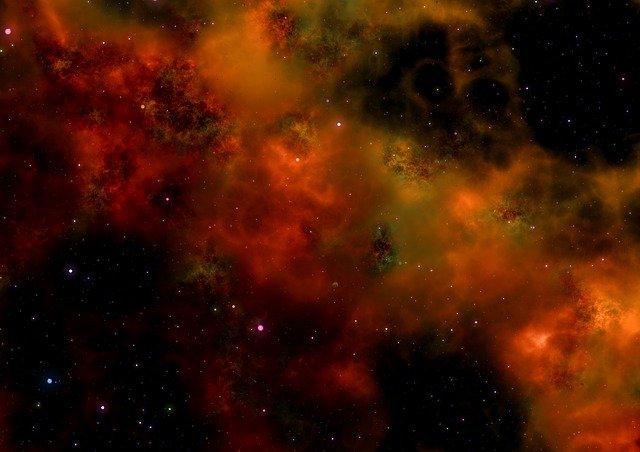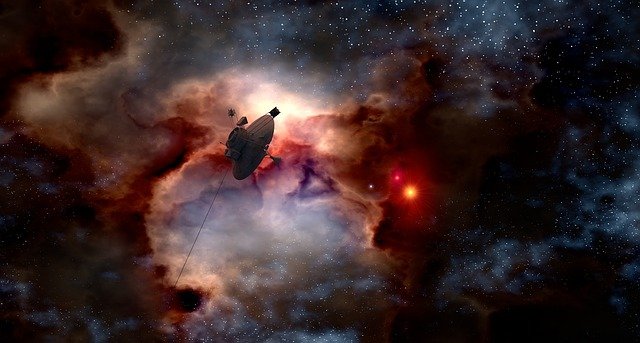Dark Matter; The Unseen Universe...
In the field of science, matter, radiation, and space, there are almost a million things we do not know, and even if we did know a few, it will take centuries to process these things not even to talk of understanding them.
 Pixabay
PixabayIn the midst of Man's breakthrough in Science and Astronomy, certain things have been brought into the light, things like black holes, inside space, dark energies and dark matter.
However, some might be true and others, hypothetical but i think, the existence of dark matter is a topic we should consider and take seriously. So, without wasting much time lets get to it then;
Dark Matter; An Unseen Universe
Right from our history till now, we've been made to understand that everything is born out of matter and that most of the things we see are basically made out of electrons, protons, neutrons, quarks, and many others.
Yet, when thorough research and study is done, you get to find that, the Universe is nearly 80% undefined and 20% defined. Some might ask "How do we know?" Well, I think the better question should be "What's beyond the seen or better still, how can we understand the Undefined.
There are missing components that haven't yet been understood even from before me or you were born. These components make up what we Call Dark-matter or Energy, a form of matter that is beyond matter itself and thanks to millions of physicist, astrophysicists and other gifted scientists, these things have been further looked into.
 Pixabay
PixabayIn lame man's Language, it is simply particles, that we can hardly even see or touch let alone understand, and to add that it's really doesn't emit light or energy but it is a form of matter.
The existence of dark matter has long been in contrast, despite the underlying fact that we might not really have concrete evidence. Although most people will think this, I would rather think differently, because Dark matter really does exist but might just be unseen.
Not until the 50s did scientists state truly that, the universe is truly much more than what it is and that it's Made up of some particles of matter that can't be seen. Dark matter is a component of our magnificent universe, that is known for its interaction with no substance.
Over time the proof that it exists has grown and is still growing. If you would, for a few seconds, stare at the stars up in space you will be amazed, you'll see a whole lot of things, and whatever lies beyond is dark matter. In its form, it can be baryonic or non-baryonic, and also it is associated with the black holes and stars in the milky ways.
 Pexels:CCO
Pexels:CCOIt Was Formally Called "The Missing Mass"
Since the confirmation of dark matter, a lot of scientists devoted time into plunging and researching about the entire galaxies looking for ways to interact with Dark Matter. In the process of trying to understand dark matter, gravitational lensing was introduced.
Formally known as the missing mass, it was first inferred by a Swiss American astronomer Fritz Zwicky, who in 1933 discovered that the mass of all the stars in the cluster of galaxies yielded only about 1 percent of the mass needed to keep the galaxies from escaping the cluster’s gravitational pull.
One way that we use to really believe in the underlying fact that dark matter exists is that most planets in the galaxies would literally just fall apart, leaving the normal rotational formation that the undergoes. Come to think of it, the movement of the planets in the galaxies in a rotational form wouldn't even be possible, if not for dark matter, so it will suggest that something big and unseen holds these planets together.
Around 1884, a speech was given by Lord Kelvin, who said that the Milky ways have an estimated number of black bodies, from his observation of the stars. His measurements, including his speech, thus concluded that the majority of stars in the Milky Way are in fact dark bodies.Later on, In 1933, Zwicky, who studied galaxy clusters, made a similar interference. He observed that the coma clusters measured up to 400times the mass that was originally visible to the normal eyes and that the unseen particles are called Dunkle Materie ('dark matter').
Over time a lot of other astrophysicists, scientist, and researchers, studied the milky way, the galaxies looking for clues relating to dark matter, many of which were fruitful, some weren't. Some breakthroughs were recorded like the discovery of gravitational lensing of background objects by galaxy clusters, and some other terms relating to dark matter, like black holes, dark energy e.t.c
The Unseen World
A lot of troubling questions might build blocks in your hearts, especially questions like "How do we prove, what we can not see?"
Logically speaking, the question sounds reasonable, but in science today, measurements of certain objects that are very large are accurately measured by studying their motion patterns.
 Pixabay
PixabayRenowned scientist, Albert Einstien, began the study of light and it's distortion, he was able to state that, certain masses or objects in the universe tends to bend and distort light, permitting them to be used as lenses. Dark matter, clumps around the milky way galaxy, and in many cases it's often referred to as, where the stars and cosmos came from.
It makes up 30.1 percent of the matter-energy composition of the universe; the rest are relative particles that we can see and then, dark energy. Naturally, the dark matter never interacts with light, which practically means that it is electromagnetically neutral.
Sadly, as fascinating as Dark matter is, it really never interacts with itself, or even anything else, because it's more of an endless form of non-baryonic substance filled with Darkness.
If there are chances that it would interact with anything, then it would really have to reduce its pace and complement other relative data in a milky way. Fascinatingly, I've observed that the number of people aware of the fact that Dark matter is beyond the skies is pretty rising. Dark matter is a lot of things, to really understand it, you've got to know all about space, the galaxies, milky way, the stars, neutrons, black holes and all of that.The existence of dark matter is further proved by the simple fact that without it, the formation of the universe wouldn't be so, it's more like what makes up the filaments of the universe in general when gravitation interacts with matter. No matter how we try, no one has ever detected a true dark matter particle except through the help of gravitational pull.
In my few months or years I've not really come across people who invest time to study about the world beyond space, the galaxies, and the milky way. However, if you wanna find out a couple of things about space, the universe, and galaxies then you should visit @astromaniac you will find out about a few things that you might not have known, or seen.
 Southern Plane of the Milky Way
Southern Plane of the Milky Waywith our eyes, like the stars, moon and other forms of entity beyond the sky.
In addition, cling to the idea that there is a world beyond this one, one where the matter is more unique and less interactive and above all a place, that even sophisticated devices or equipment cannot see, let alone the naked eye.
Finally, I'll end by saying this, Dark matter, is more than just matter, it is the universe itself, it holds the cosmos, it makes up the entities in deep space, and besides the fact that we don't really know what shape, form, type or manner it takes, for it is what makes up the dark sector.
Reference
For the love of science, universe, cosmos, and space

